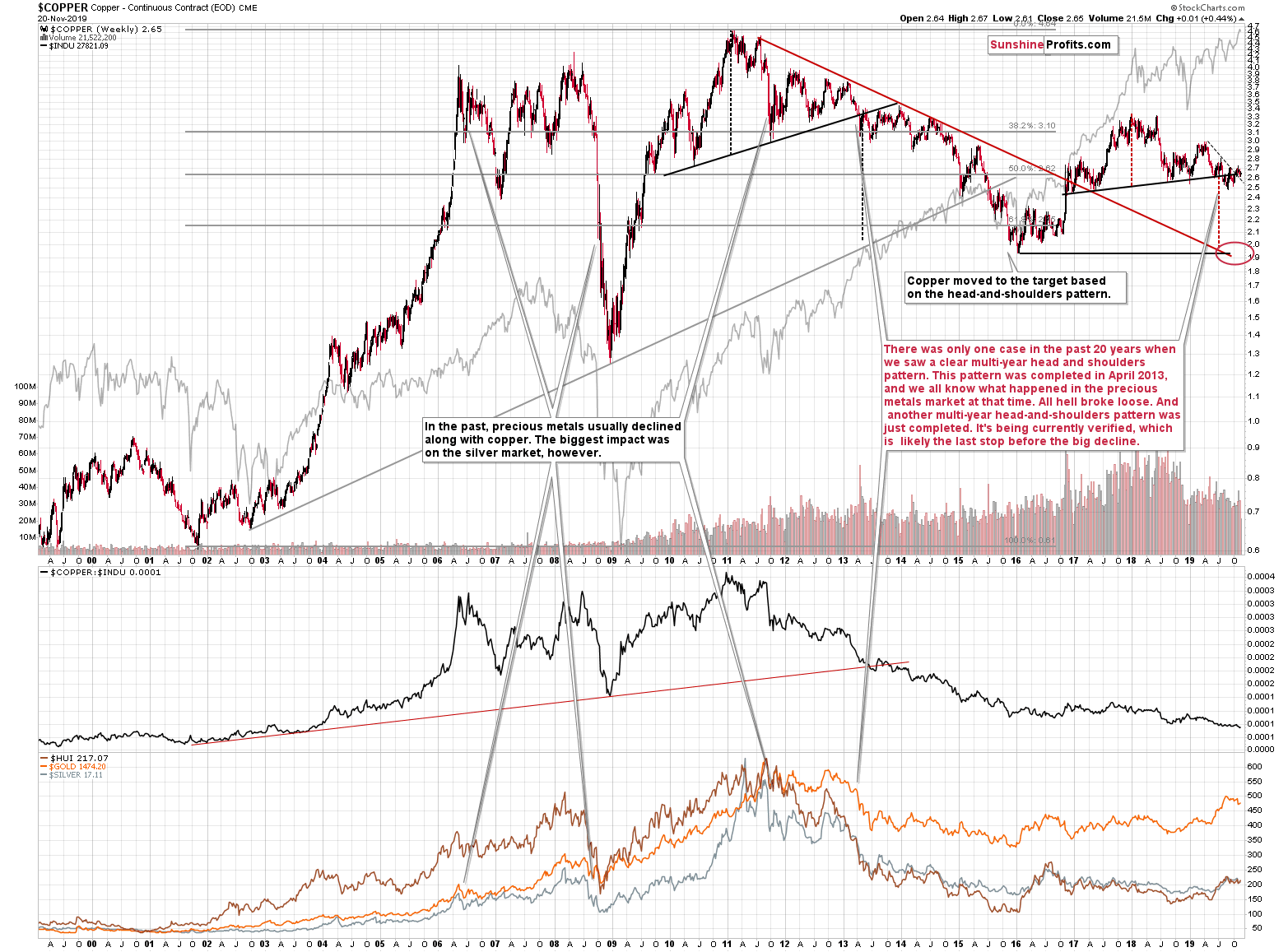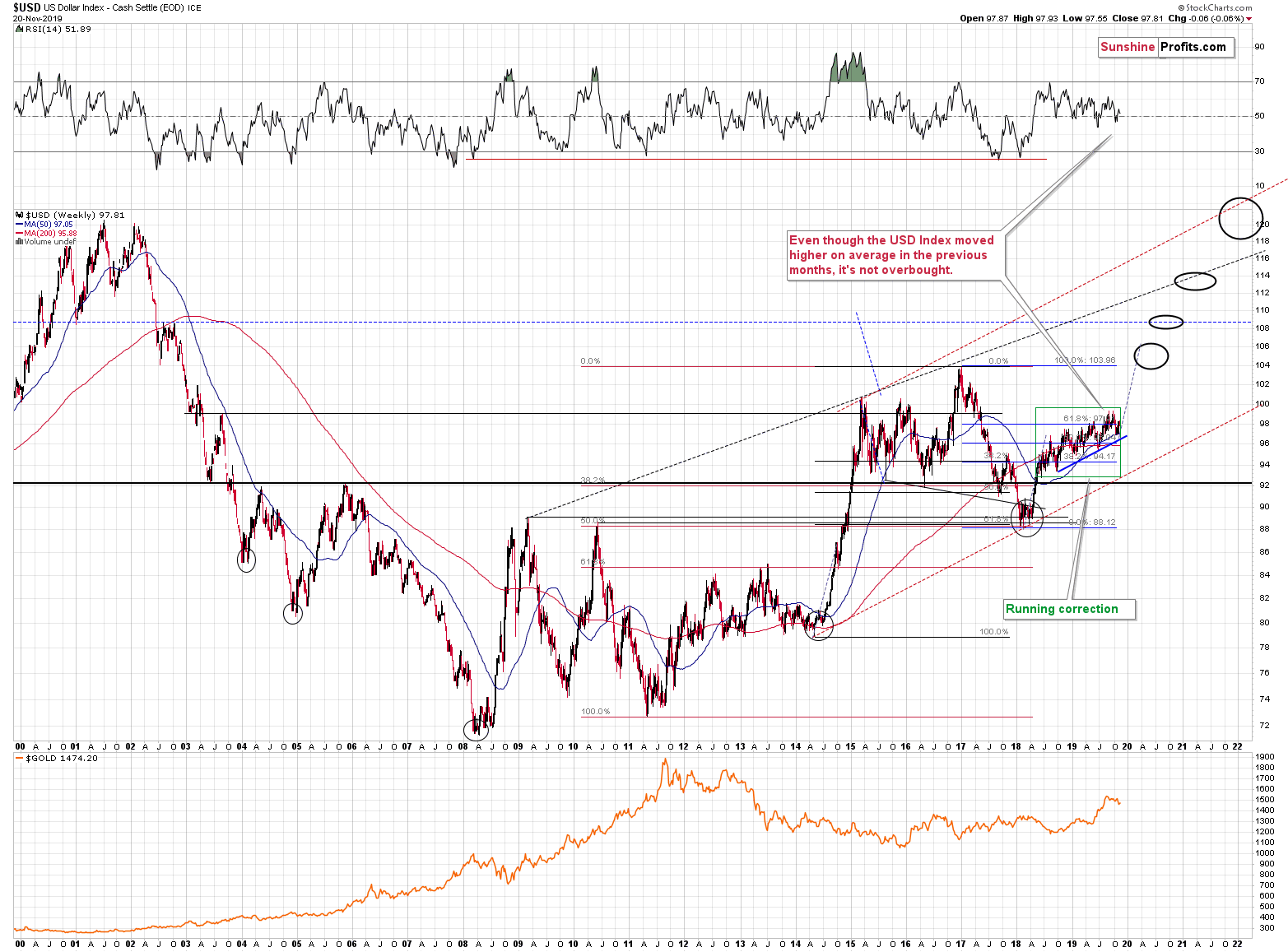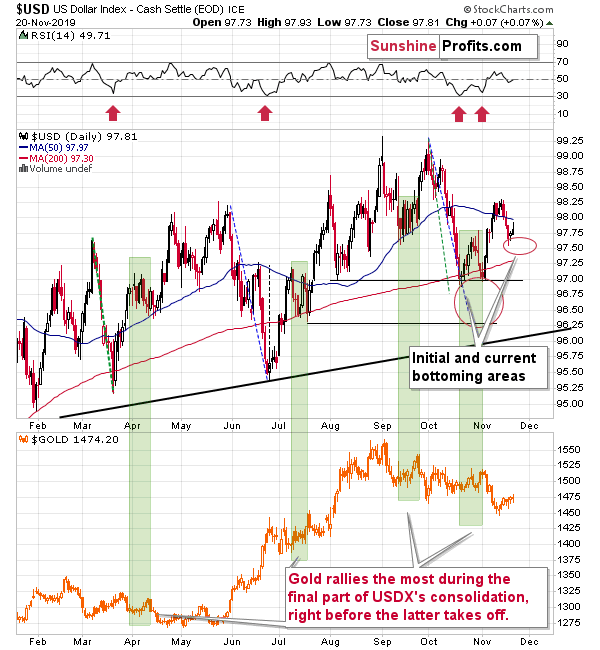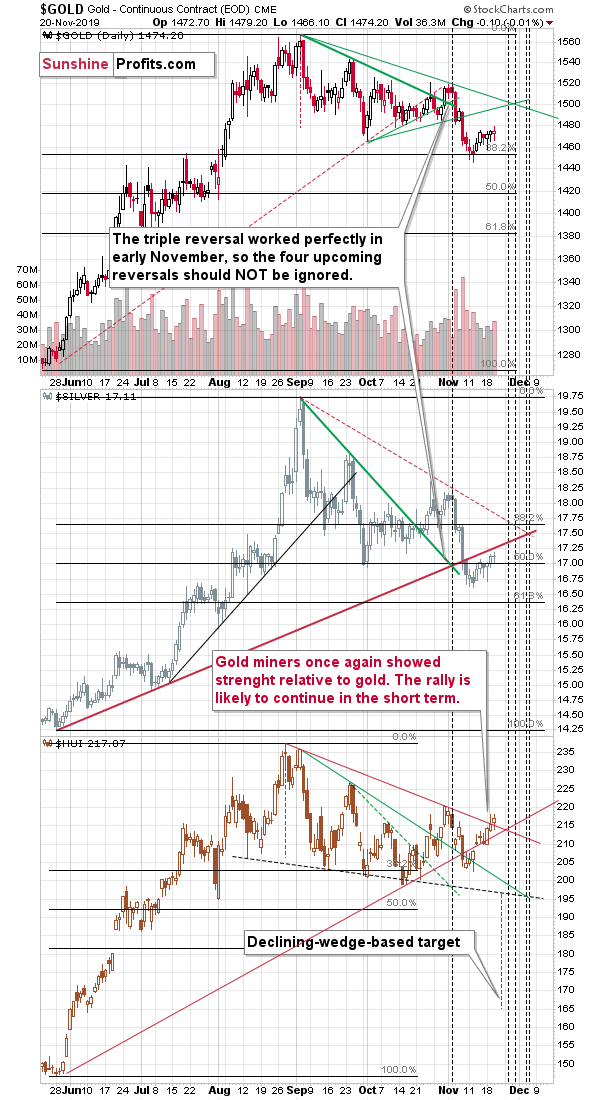Briefly: in our opinion, small (50% of the regular size of the position) speculative long positions in gold, silver, and mining stocks are justified from the risk/reward point of view at the moment of publishing this Alert.
Let's continue with yesterday's way of starting the Alert, and keep the focus on the big picture. This time, we'll go beyond the precious metals market and into the industrial world. But don't worry, we'd still analyze the PM realm. Analyzing copper - because that's what we're going to do - is not very far from analyzing silver, for instance. Out of all the metals, copper is the second best conductor of electricity and heat, while silver is the first (it's 6% better in case of electricity, and electricity and heat conduction are based on the same property of metals' atomic structure, by the way). Gold takes the third place in the ranking.
If the similarity ended there, it would be of little use from the investment point of view. Fortunately, there's much more to discuss as copper has been forming a very specific chart pattern since 2017 and when it did that previously, something epic happened in the precious metals market.
Copper's Ongoing Pattern
The patter is a huge head-and-shoulders formation, and we previously saw it between late 2009 and early 2013. And you know very well what happened in 2013. Gold, silver, and mining stocks plunged without giving it a second thought. The decline in the precious metals market happened right after copper successfully broke below the H&S pattern. before that happened gold showed some strength, rallying to its previous highs, while gold miners and silver moved higher, but nowhere close to analogous price levels.
The same thing is happening right now. Gold topped well above its 2016 high, but silver and gold stocks refused to move much higher. They just corrected the decline that started at the 2016 highs - nothing more.
History tends to repeat itself, so we're probably right before a bigger decline in the PMs. The situation in the USD Index definitely confirms it.
Copper broke below its big head-and-shoulders pattern earlier this year. Then it invalidated the breakdown. Then it broke lower again. And invalidated the breakdown again. Right now, copper is trading practically right at the neck level of the pattern, meaning that it could break lower any month, week, or day. This may or may not happen immediately, but a rally in the USD Index could definitely trigger copper's decline. After all, their long- and medium-term moves have been quite aligned.
The USD Index Long-Term
The 2008 and 2011 bottoms in the USD Index clearly correspond to copper's tops and many medium-term moves in copper are a reflection of what the USD Index has been doing. For instance, the running correction that has been in place since mid-2018 corresponds to copper's right shoulder of the H&S pattern along with the prolonged test of the breakdown below the neck level.
Once the USD Index breaks higher, the odds are that copper's breakdown will result in much lower values. The precious metals market is likely to react all this with a big decline as well.
Before that happens, gold is likely to move higher, and we just saw another indication that it will move higher in a way that we had previously outlined.
The USD Index Short-Term
Namely, the USD Index formed a small daily reversal, which suggests that the next quick move in the USDX value is going to be down. Ultimately, the USDX ended the day higher, but gold didn't really react. It's probably going to react once the USDX tests its recent lows or trades close to them (perhaps a bit below them). All in all, our previous comments on the above chart remain up-to-date:
Now, since the USD Index already moved to our target area, there comes the question of whether this is likely to translate into a top in gold or not. Our answer is that it indicates that the top is relatively close, but not necessarily in yet.
You see, the link between gold and the USD Index is not as straightforward at it may appear at first sight. People will usually expect gold to move higher on the same day when the USD Index moves lower and vice-versa. And it quite often happens in this way. However, the strength of reaction varies. In fact, it could vary so much that moves in the USDX are going to be mostly ignored once the day-to-day price noise is filtered out.
In today's Alert, we will focus on the very specific part of the gold-USD dynamics - on gold's behavior during USD's consolidations. And more precisely, what happens if the USD Index continues to move sideways for a while and soars only after some time.
After all, that's exactly what could happen right now. The USD Index has already moved to our target area, but it doesn't automatically mean that the next upswing has to start immediately. In fact, pauses before rallies were quite common in the previous months. We marked those cases with green rectangles.
There were four similar cases this year. In two cases, the USDX consolidated after rallying and in two cases, it consolidated after declining. And yet, as far as the consolidation itself is concerned, we see the same kind of reaction in gold in all four of them.
Gold rallied most visibly when the consolidation in the USD Index was ending.
This is profound, because it means that the USD Index doesn't have to slide from here for gold to move higher in the next several days. The USD Index might move back and forth (perhaps slightly higher or slightly lower) and gold could form the final short-term pop-up just like it did in mid-April, mid-July, late-September, and late-October. In other words, our USD Index analysis doesn't invalidate our gold analysis.
Of course, if the USD Index declines some more, then gold would likely rally anyway.
That's the outlook for the short term and the short term only. After it's all said and done and the dust settles, the USDX is likely to resume it's medium- and long-term trends.
Indeed, the USDX didn't have to decline for gold to rally. Gold moved a bit higher yesterday and the same thing happened in the dollar. At the moment of writing these words, this subtle sign is being confirmed - gold is up by $3, while the USD Index is up by 0.10.
It seems that the USD Index is forming a broad bottom, similarly to what it did in July, September, and October, and gold is likely to rise slowly as it happens, and then pop up higher at the very end of its rally and USD's bottom. The history is likely to repeat itself and we are likely to get a good exit price on our profitable long positions and a good entry price for the upcoming short positions. Naturally, we'll keep you - our subscribers - informed.
There's one more thing that we would like to comment on today - the miners' breakout.
The PMs Short-Term
Gold and silver were practically flat yesterday, but the HUI Index moved higher and closed the day above the declining red resistance line. This strength is a bullish indication for the short term.
What didn't happen is even more important that what did. Gold miners didn't decline even though the we saw a shooting star reversal candlestick on Tuesday. As we wrote yesterday, it was unlikely that this reversal would trigger a decline, as it was accompanied by low volume:
The volume on which GDX reversed yesterday was small, which means that there was no fierce battle between the buyers and sellers and that it was simply a "meh" day, where the price action was relatively inconclusive. We can't say that it was a tiny-volume upswing, because there was barely any upswing to speak of. The 3-cent move in terms of the closing price changes is more of a pause than a move.
Moreover, please note that the HUI Index is still several days away from the first of the triangle-based reversal dates, so the rally is likely to continue in the short term.
Also, the key bearish factors for the medium term remain intact - the outlook is bullish only for the short term.
Key Factors to Keep in Mind
Critical factors:
- The USD Index broke above the very long-term resistance line and verified the breakout above it. Its huge upswing is already underway.
- The USD's long-term upswing is an extremely important and bearish factor for gold. There were only two similar cases in the past few decades, when USD Index was starting profound, long-term bull markets, and they were both accompanied by huge declines in gold and the rest of the precious metals market
- Out of these two similar cases, only one is very similar - the case when gold topped in February 1996. The similarity extends beyond gold's about a yearly delay in reaction to the USD's rally. Also the shape of gold price moves prior to the 1996 high and what we saw in the last couple of years is very similar, which confirm the analysis of the gold-USD link and the above-mentioned implications of USD Index's long-term breakout.
- The similarity between now and 1996 extends to silver and mining stocks - in other words, it goes beyond USD, gold-USD link, and gold itself. The white metal and its miners appear to be in a similar position as well, and the implications are particularly bearish for the miners. After their 1996 top, they erased more than 2/3rds of their prices.
- Many investors got excited by the gold-is-soaring theme in the last few months, but looking beyond the short-term moves, reveals that most of the precious metals sector didn't show substantial strength that would be really visible from the long-term perspective. Gold doesn't appear to be starting a new bull market here, but rather to be an exception from the rule.
- Gold stocks appear to be repeating their performance from 20 years ago, which means that a bottom in the entire precious metals sector is quite likely to form at much lower prices, in about a year
Very important, but not as critical factors:
- Long-term technical signs for silver, i.a. the analogy in terms of price to what we saw in 2008, shows that silver could slide even below $10.
- Silver's very long-term cycles point to a major reversal taking place right now and since the most recent move was up, the implications are bearish (this is also silver's technical sign, but it's so important that it deserves its own point)
- Long-term technical signs for gold stocks point to this not being a new gold bull market beginning. Among others, it's their long-term underperformance relative to gold that hint this is rather a corrective upswing within a bear market that is not over yet.
- Record-breaking weekly volume in gold is a strong sign pointing to lower gold prices
Important factors:
- Extreme volume reading in the SIL ETF (proxy for silver stocks) is an effective indication that lower values of silver miners are to be expected
- Silver's short-term outperformance of gold, and gold stocks' short-term underperformance of gold both confirm that the precious metals sector is topping here
- Gold topped almost right at its cyclical turning point, which makes the trend reversal more likely
- Copper broke below its head-and-shoulders pattern and confirmed the breakdown. The last time we saw something similar was in April 2013, when the entire precious metals sector was on the verge of plunging lower.
Moreover, please note that while there may be a recession threat, it doesn't mean that gold has to rally immediately. Both: recession and gold's multi-year rally could be many months away - comparing what happened to bond yields in the 90s confirms that.
Summary
Summing up, the outlook for the precious metals sector remains very bearish for the following months (also because of the record open interest in gold), but it seems that we will first see a short-term upswing before the decline continues. Based on what we saw in the last few days, the bullish outlook remains justified. It seems that the profits on our long positions will become bigger before we close it. We expect to close the long position within the next 1-2 weeks, but it might happen sooner, for instance should we see a sharp rally and a reversal shortly. We plan to then open a short position shortly after closing the long one.
As always, we'll keep you - our subscribers - informed.
To summarize:
Trading capital (supplementary part of the portfolio; our opinion): Small speculative long position (50% of the full position) in gold, silver, and mining stocks is justified from the risk/reward perspective with the following stop-loss orders and binding exit profit-take price levels:
- Gold: profit-take exit price: $1,489.80; stop-loss: $1,437; initial target price for the UGLD ETN: $135.88; stop-loss for the UGLD ETN: $122.10
- Silver: profit-take exit price: $17.47; stop-loss: $16.27; initial target price for the USLV ETN: $89.33; stop-loss for the USLV ETN: $72.44
- Mining stocks (price levels for the GDX ETF): profit-take exit price: $27.88; stop-loss: $25.47; initial target price for the NUGT ETF: $30.27; stop-loss for the NUGT ETF $23.08
In case one wants to bet on junior mining stocks' prices, here are the stop-loss details and target prices:
- GDXJ ETF: profit-take exit price: $39.27; stop-loss: $35.38
- JNUG ETF: profit-take exit price: $67.97; stop-loss: $49.83
Long-term capital (core part of the portfolio; our opinion): No positions (in other words: cash)
Insurance capital (core part of the portfolio; our opinion): Full position
Whether you already subscribed or not, we encourage you to find out how to make the most of our alerts and read our replies to the most common alert-and-gold-trading-related-questions.
Please note that the in the trading section we describe the situation for the day that the alert is posted. In other words, it we are writing about a speculative position, it means that it is up-to-date on the day it was posted. We are also featuring the initial target prices, so that you can decide whether keeping a position on a given day is something that is in tune with your approach (some moves are too small for medium-term traders and some might appear too big for day-traders).
Plus, you might want to read why our stop-loss orders are usually relatively far from the current price.
Please note that a full position doesn't mean using all of the capital for a given trade. You will find details on our thoughts on gold portfolio structuring in the Key Insights section on our website.
As a reminder - "initial target price" means exactly that - an "initial" one, it's not a price level at which we suggest closing positions. If this becomes the case (like it did in the previous trade) we will refer to these levels as levels of exit orders (exactly as we've done previously). Stop-loss levels, however, are naturally not "initial", but something that, in our opinion, might be entered as an order.
Since it is impossible to synchronize target prices and stop-loss levels for all the ETFs and ETNs with the main markets that we provide these levels for (gold, silver and mining stocks - the GDX ETF), the stop-loss levels and target prices for other ETNs and ETF (among other: UGLD, DGLD, USLV, DSLV, NUGT, DUST, JNUG, JDST) are provided as supplementary, and not as "final". This means that if a stop-loss or a target level is reached for any of the "additional instruments" (DGLD for instance), but not for the "main instrument" (gold in this case), we will view positions in both gold and DGLD as still open and the stop-loss for DGLD would have to be moved lower. On the other hand, if gold moves to a stop-loss level but DGLD doesn't, then we will view both positions (in gold and DGLD) as closed. In other words, since it's not possible to be 100% certain that each related instrument moves to a given level when the underlying instrument does, we can't provide levels that would be binding. The levels that we do provide are our best estimate of the levels that will correspond to the levels in the underlying assets, but it will be the underlying assets that one will need to focus on regarding the signs pointing to closing a given position or keeping it open. We might adjust the levels in the "additional instruments" without adjusting the levels in the "main instruments", which will simply mean that we have improved our estimation of these levels, not that we changed our outlook on the markets. We are already working on a tool that would update these levels on a daily basis for the most popular ETFs, ETNs and individual mining stocks.
Our preferred ways to invest in and to trade gold along with the reasoning can be found in the how to buy gold section. Additionally, our preferred ETFs and ETNs can be found in our Gold & Silver ETF Ranking.
As a reminder, Gold & Silver Trading Alerts are posted before or on each trading day (we usually post them before the opening bell, but we don't promise doing that each day). If there's anything urgent, we will send you an additional small alert before posting the main one.
Thank you.
Sincerely,
Przemyslaw Radomski, CFA
Editor-in-chief, Gold & Silver Fund Manager







